Thirteen years ago, the Sultana Foundation was looking for a new project. Schooner Sultana had been built and launched, and it was already making its mark as a vehicle for educating the public about the history and ecology of the Chesapeake Bay region. But it was time to try something new – to “build another cool ship,” as Chris Cerino said.

Chris Cerino, vice-president of Sultana
As it happened, the 400th anniversary of a landmark in Chesapeake history was just a few years away. That was Captain John Smith’s voyage of discovery up the Bay and its tributaries from the new Jamestown settlement in Virginia. Cerino, Sultana’s education director, was a huge fan of Smith’s voyage, and he suggested a recreation of the shallop Smith had used – a starkly utilitarian vessel that carried a crew of 25 on a 1,500-mile trip that opened up new territories for the English to explore – and eventually to settle.
Cerino and Sultana President Drew McMullen agreed on the project and commissioned John Swain, the shipwright who built Sultana, to take it on. But it soon became clear that they were aiming for something more than just building a fancy archaic rowboat. Why not use the boat to retrace Smith’s voyage, with stops along the way to carry forward Sultana’s educational mission by telling people about the history and environment as the crew experienced it?
At Sultana Education Foundation’s headquarters on Cross Street in Chestertown, May 10, members of the shallop’s crew reunited for the first time since the conclusion of their 2007 voyage, with a standing room audience in attendance to hear their recollections. Ten of the 12 original crew members were on hand, along with Colleen Moore Whitlock, who had worked to set up events at various stops along the itinerary. Cerino and McMullen served as narrators. “This is a cool night for us at Sultana,” McMullen said, greeting the crowd. “We are seeing people we have not seen in ten years and telling a story that we’re still very much involved with today – but this is how the story started out.”

Drew McMullen, Sultana’s President, introduces the crew at the 10th year anniversary.
As the project to recreate the shallop went forward, McMullen said, its leaders became aware of a larger project to establish Smith’s route. That led to a collaboration with the Chesapeake Conservancy and the National Park Service, which together sought to create the nation’s first National Historic Water Trail along the route Smith had traveled four centuries ago.
McMullen introduced Joel Dunn of the Chesapeake Conservancy, who told of the organization’s roots in the effort to establish the John Smith trail, and its continuing effort to protect “the most beautiful places along the John Smith trail for current and future generations to enjoy.” Among its accomplishments was the purchase of Werowocomoco, a 300-acre tract that Dunn described as the most important Native American site in the eastern U.S. – the site where Smith met Powhatan’s chieftains on his voyage.
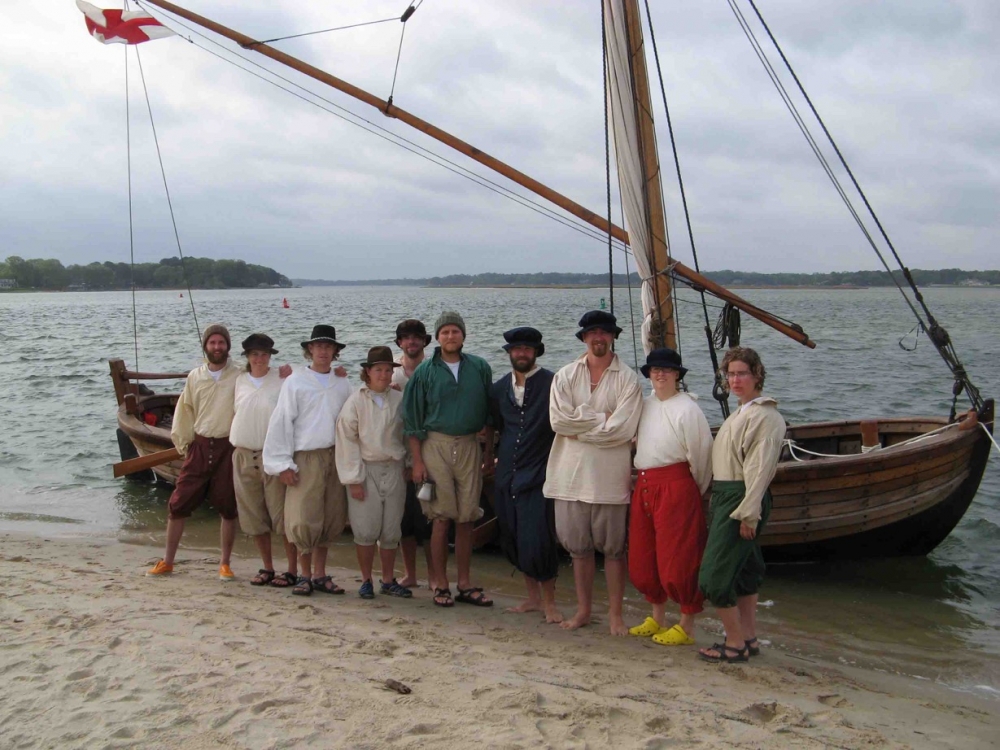
The John Smith Shallop with the crew in their kits on April 27, 2007
Bob Campbell of the National Park Service said the recreated voyage “captured people’s imagination… and put wind in our sails.” He said the Sultana headquarters had been designated a National Park Service visitor’s center. “This trail exists by the efforts and commitment of our partners, and no finer partner exists than the Sultana Education Foundation,” he said, praising the creativity and innovation of Sultana and the Conservancy.
Cerino took over the microphone and gave a “Cliff’s Notes” overview of Smith’s voyage and how Sultana went about recreating it, with an entertaining slide show accompanying his comments. He then brought in the crew members to tell their experiences and thoughts on the 2007 voyage.
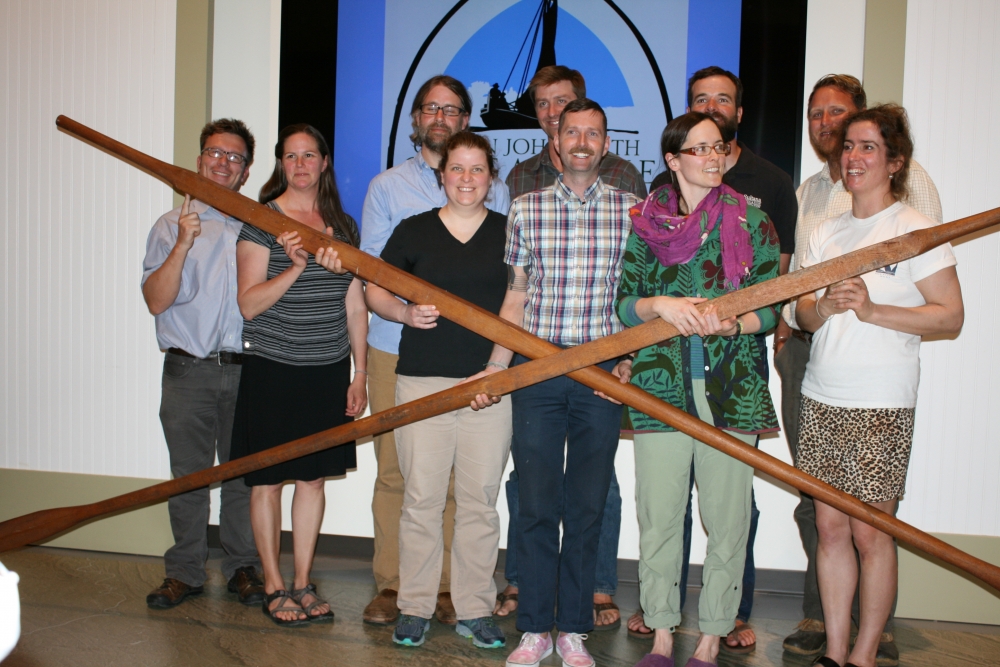
Ten years later: The crew in 2017 – Bill Ryall, Liz Schale, Ian Bystrom (captain), Leona Dalton, Austin Hall, Donkey Dover, John Mann, Ashley Maloney, Forrest Richards, and Rebecca Psowski. (Not pictured are Andy Bystrom and Kelly Poole) Note that Bill Ryall can hold up his end with just one finger!
Seated on stools along the wall with the video screen were Ian Bystrom, who captained the shallop; Bill Ryall, Liz Schale, Leona Dalton, Austin Hall, Donkey Dover, John Mann, Ashley Maloney, Forrest Richards, and Rebecca Psowski. (Two other crew members, Andy Bystrom and Kelly Poole, were unable to attend.) Each in turn offered their memories of the voyage and their part in it.
Ian Bystrom led off by noting that nobody had any idea how fast the boat would be or whether it would be able to maintain the rigorous schedule of stops the sponsors had committed it to. As it turned out, he said, “It rowed poorly; it also sailed poorly.” The crew developed a rowing routine, with six rowers at a time taking half-hour shifts. The average speed was about 2.5 knots rowing and 4 to 5 knots sailing, under the best conditions. In shallow water, the crew would often go overboard and tow the vessel.
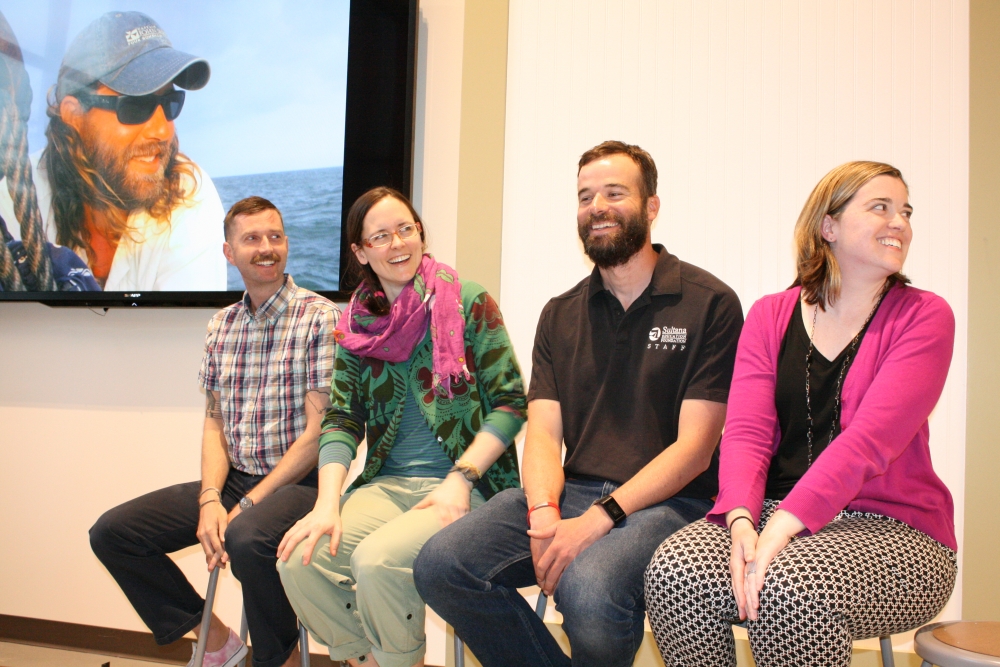
Crew members laugh at the shared memories. From left – Donkey Dover, Ashley Maloney, John Mann, Colleen Moore Whitlock (Captain Ian Bystrom is shown on screen in 2007 photo)
Schale told how the crew prepared for the trip, studying the history of the bay, early navigation, the Indian population of the area, and a host of other topics relevant to recreating Smith’s voyage. They also worked on conditioning themselves for the physical demands of the trip.
Hall talked about feeding the crew on a vessel without refrigeration during a hot summer voyage. The crew subsisted on a limited menu: lots of pasta and marinara sauce, macaroni shells with peas and Velveeta, red beans and rice, “anything you could put in a wrap” for lunch. “We actually had decent coffee,” he said, thanks to a donation from a local coffee roaster. Surprisingly, despite the steady work of rowing, everyone gained weight. He also gave the answer to the most frequently-asked question: “Where do you go to the bathroom?” The answer: a “luggable loo,” essentially a covered plastic bucket. And the crew members developed “a keen sense of radar for porta-potties or marinas with restroom facilities.
For Ryall, the most stressful part of the voyage was setting up the tent and exhibits at the 30-odd stops where the crew would talk to hundreds of locals for eight to ten hours about the voyage, its history and the ecology of the bay. “It was kind of a pleasure to get back on the water where you didn’t have to talk to people,” he said. But he credited the pre-voyage training for the crew’s ability to deliver a coherent story about the Bay.
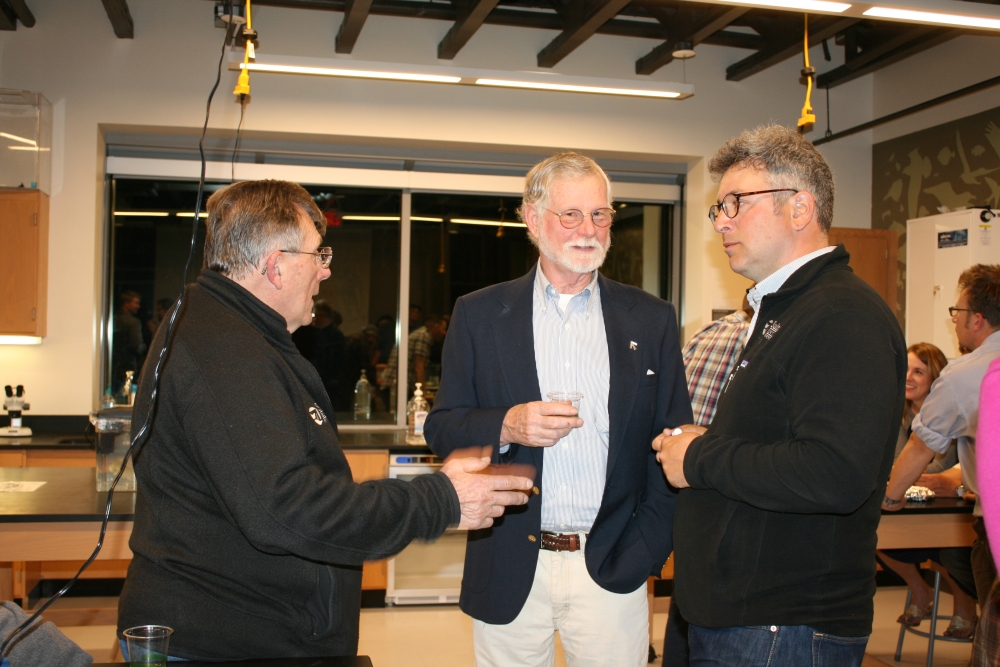
George Kreshock, board member; John Swain, shipwright & original builder/designer of the Sultana, with audience member
Dalton said she found it fascinating how much the Bay had changed over 400 years, comparing modern conditions to Smith’s accounts of huge schools of fish, oyster reefs large enough to inhibit navigation, and thick flocks of birds.
Dover discussed the sleeping arrangements. It wasn’t uncommon for crew members to grab a quick nap in between their 30-minute shifts of rowing. At night, they would look around for a marina or a waterside property with a yard they could pitch their tents in. They often ended up asking bayside property owners’ permission to camp out – permission they were almost invariably granted after showing letters from the governors of Maryland and Virginia. But it was often necessary to row at night, to take advantage of a favorable tide. The best nights were those when they were scheduled for an educational event the next day – “then we would sleep in a motel,” Dover said.
The crew’s encounters with the descendants of the native tribes Smith had met, to Maloney, “was a really neat opportunity for us.” She said a lot of Maryland shows evidence of the land being used by Indians. “During the trip, we would have people of native descent come visit us and talk with us and teach us about their cultures.” She said it was instructive to imagine how Smith and his sailors reacted to the thriving culture they found around the Bay. “We had (Indians) escorting us and rowing along-side as we came into the exhibit (in Fredricksburg),” she said.
There are eight Indian tribes in Virginia still living on the land where Smith encountered them, and several groups in Maryland, Cerino added. “It was really kind of cool to meet these descendants; it’s a big part of the story that sort of gets whitewashed in the history books,” he said.
John Mann talked about some of the undeveloped landscapes the crew saw during their voyage, illustrated by slides taken during the voyage. He told of traveling one stretch along the Rappahannock where a fleet of Indian canoes came out and herded Smith’s shallop toward shore, where a flight of arrows came down on them. “It was kind of neat because we’d read about that experience ahead of time. You can imagine that you’re back there, because you’re not really seeing much of modern life.” On a river like the Nanticoke, lined with considerable marshland, he said, “you can paddle for miles without seeing a dock or a house.” He credited Schale, an avid birder, with helping identify the various species they saw. Pulling a seine net through shallow water, as they did with kids at the various stops, gives a clear idea how much life there still is in the Bay, he said.
Colleen Moore Whitlock was not a crew member, but she arranged for all of the 30-plus shore exhibits and helped the crew set them up. She told how much interest there was in all the small towns along the bay. “The town councils would be involved and the local museums – everybody in these small towns would just come out.” She remembered being on the Mall in Washington and meeting former Gov. Martin O’Malley in Annapolis. A huge flotilla came down from Port Deposit to meet the shallop at Perryville, she said. Since then, she has worked as Director of Administration for the Chesapeake Conservancy, continuing to work for the Bay.
The final discussion topic was unique experiences from the voyage, answered by Psowski and Richards. Richards told about coming out of the mouth of the Rappahannock and finding themselves in the midst of a pod of 25 to 30 dolphins. The boat was under sail, so the crew members let out a couple of dock lines from the stern and “went for a swim with the dolphins.” He recalled how they “smoked everyone” at the “great Chesapeake Bay shallop race,” where they were the only one of the three boats to finish.
Psowski said the story she told most often was from the end of the summer, when they returned to a campsite they had previously used. Rowing into shore, they realized they were making very poor speed despite having built up their strength and endurance over nearly 1,600 miles. “We got really dispirited,” she said, feeling they’d lost their edge. Finally, as they pulled up to the beach, they realized they’d been pulling a crab pot behind them for miles.
Cerino then asked each to tell their takeaway from the voyage. Richards said doing the voyage at such a slow pace gave a perspective “probably nobody has seen in 400 years.”
Whitlock was inspired by how enthusiastic and resilient the crew was during the arduous voyage.
Mann said the generosity of people who let them use their bathrooms and sleep in their yards “restored my faith in humanity.”
For Maloney, the voyage gave her background material for her current studies as a Ph.D. student in oceanography.
Ryall said historians briefing them at the beginning of the voyage were skeptical of some of the distances Smith claimed his shallop had covered. But the modern crew managed to duplicate and even exceed some of his records, proving it was possible.
The trip gave Dalton a new understanding of how beautiful the Bay still is, she said.
Hall said the low-tech environment of the trip, without smartphones or the 24-hour news cycle, was “a paradigm shift” for him. “You don’t need everything you think you do,” he said.
To Schale, the remarkable fact was that, despite the pressure and primitive conditions of the voyage, “we didn’t fight.” The crew had a common goal and it left no room for petty disagreements. She also commented on how there are pockets of wilderness everywhere, even in urban environments – “the edge of a parking lot, the edge of a roadway” – that she finds peace in.
For Bystrom, the most important takeaway from the trip was all the relationships he made with others in the crew, and he felt “they’ll endure the rest of my life.”
Cerino said the voyage gave him a greater appreciation for the whole Bay, and expanded the vision and mission of Sultana. “If you don’t get out there, you don’t know what needs to be improved or saved, what’s cool that’s still out there.”
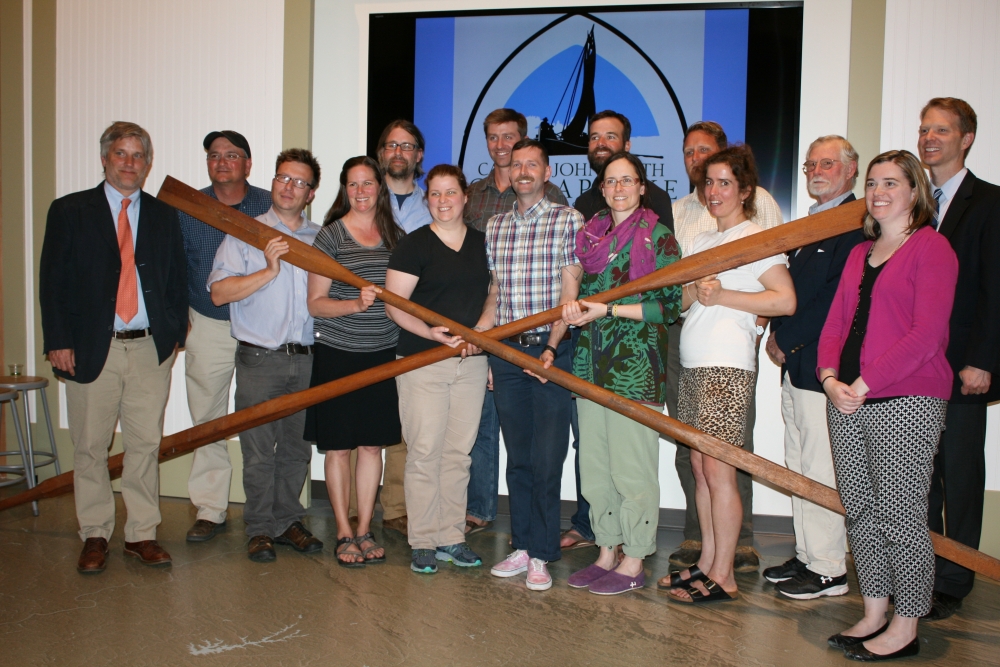
Drew McMullen, Chris Cerino, Bill Ryall, Liz Schale, Ian Bystrom (captain), Leona Dalton, Austin Hall, Donkey Dover, John Mann, Ashley Maloney, Forrest Richards, Rebecca Psowski. John Swain, Colleen Moore Whitlock, Joel Dunn
Visit these websites for more information: Sultana Education Foundation
Captain John Smith Chesapeake National Historic Trail
Photos from 2007 courtesy of Sultana Education Foundation. Other photos by Jane Jewell
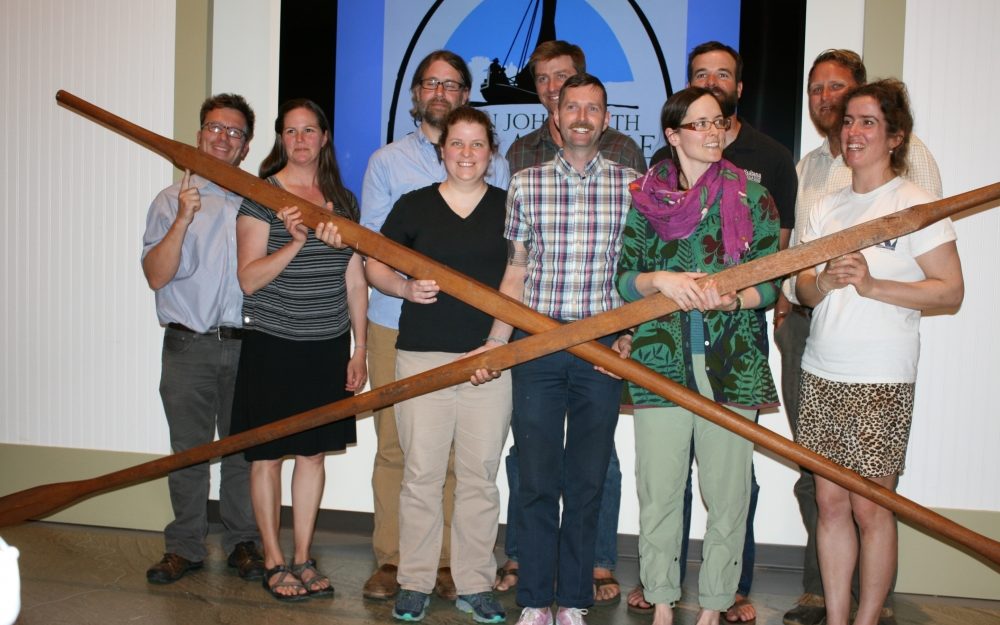


Write a Letter to the Editor on this Article
We encourage readers to offer their point of view on this article by submitting the following form. Editing is sometimes necessary and is done at the discretion of the editorial staff.